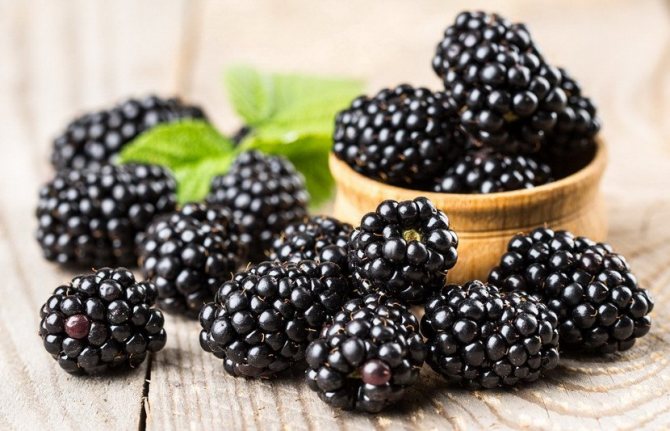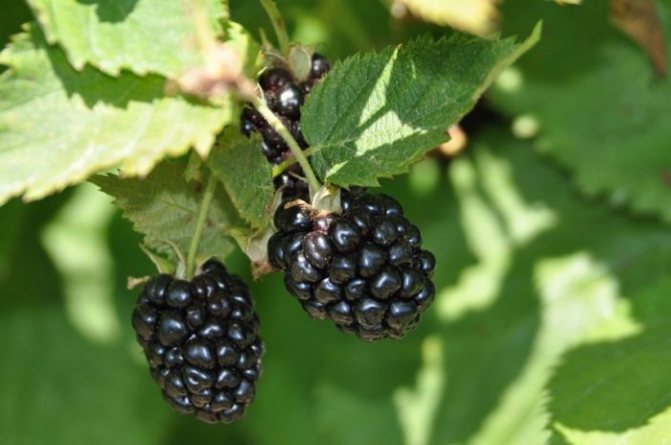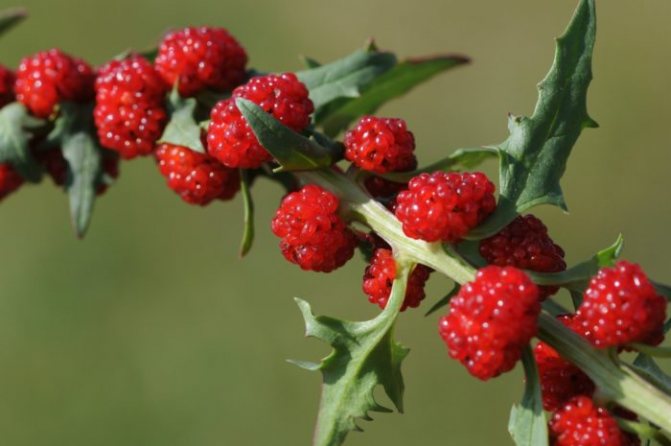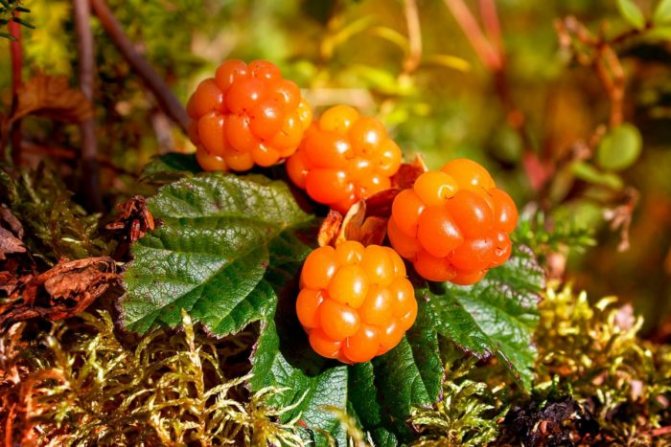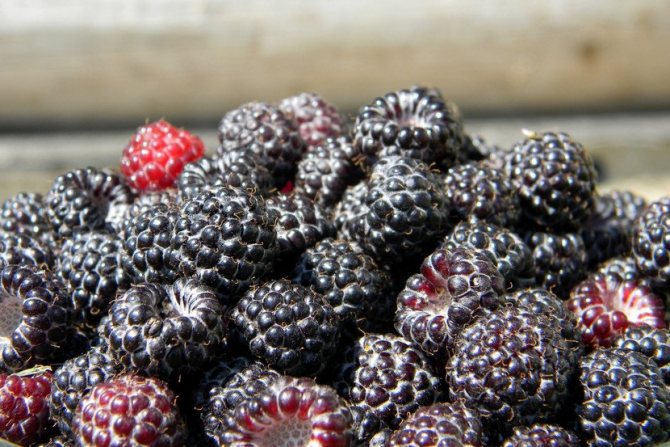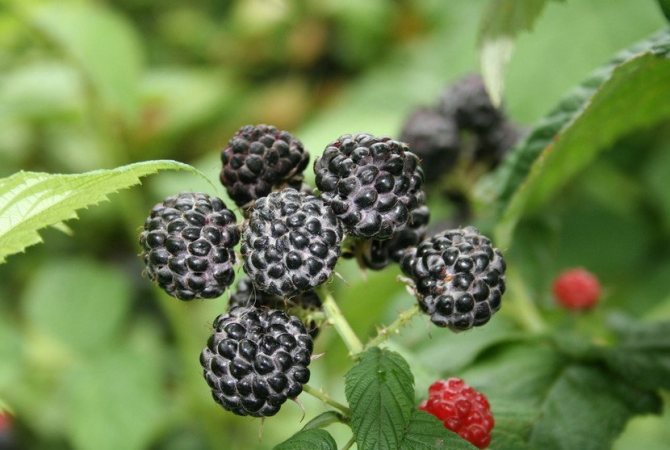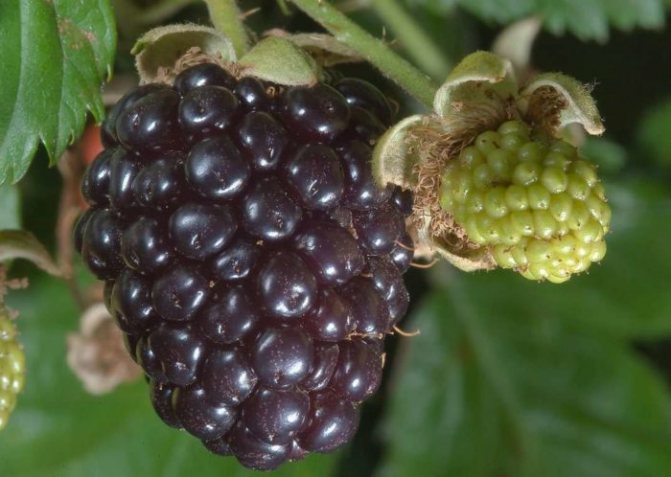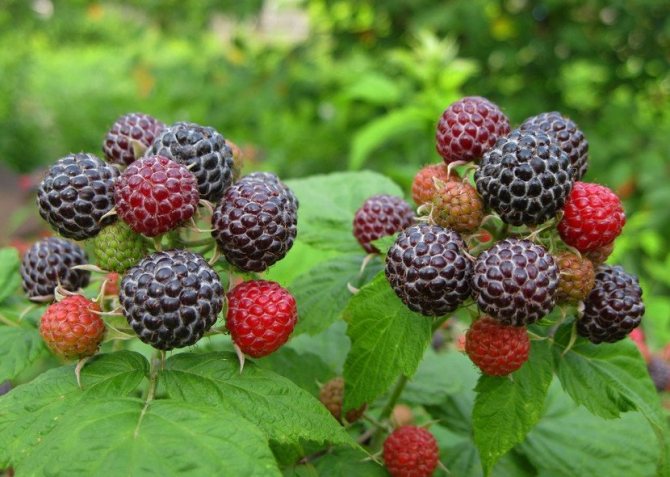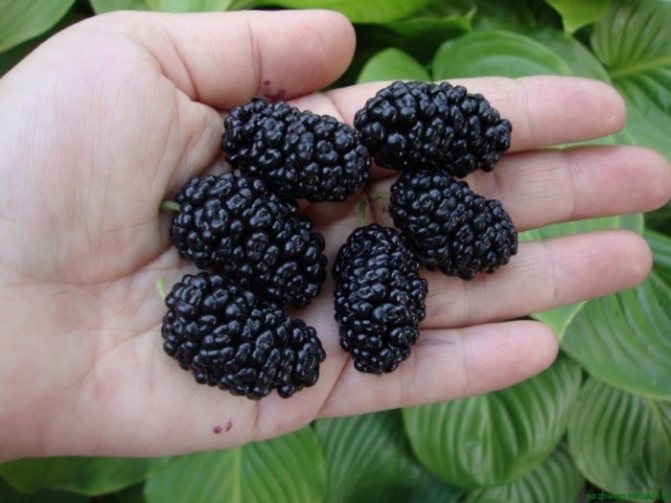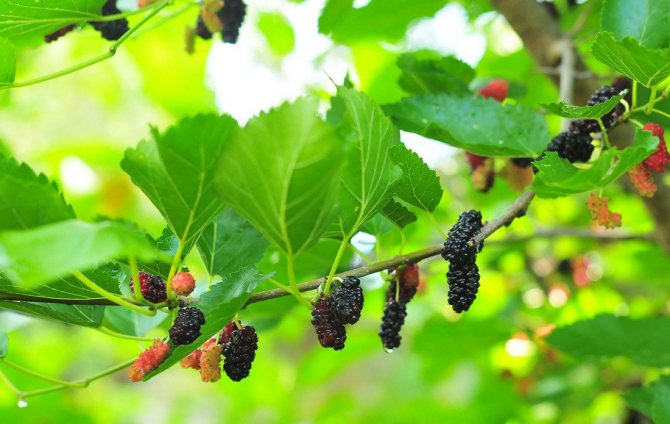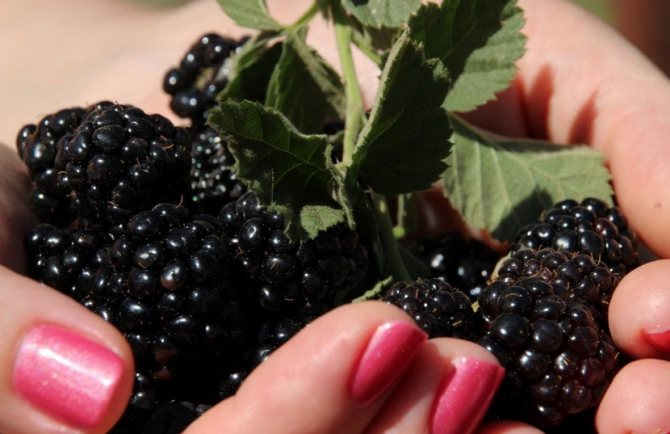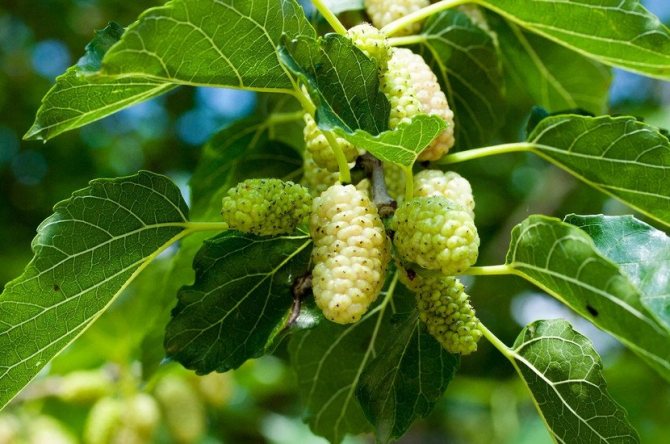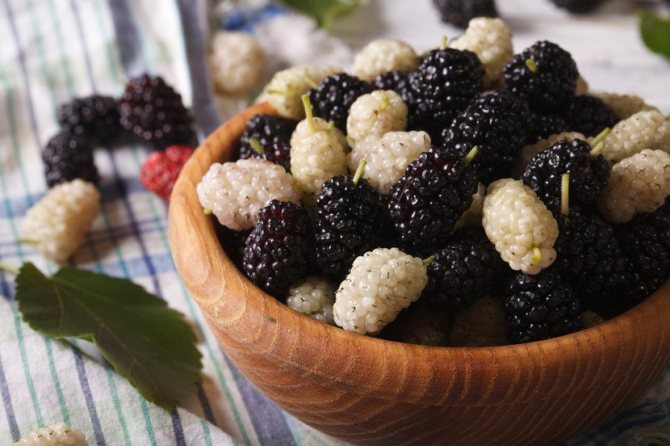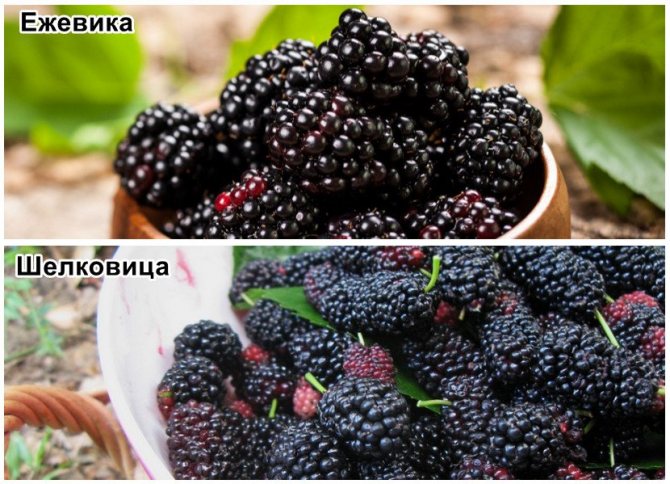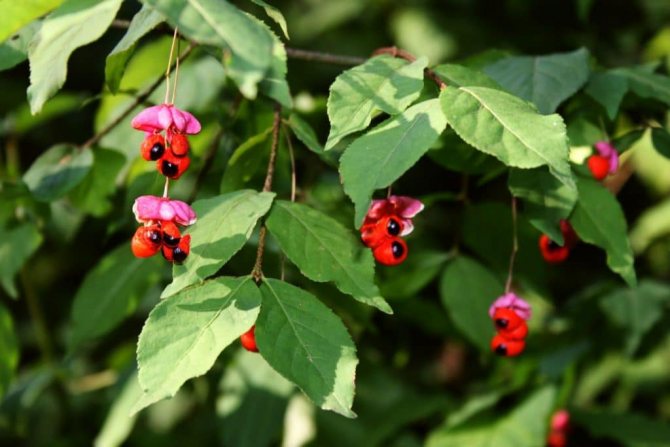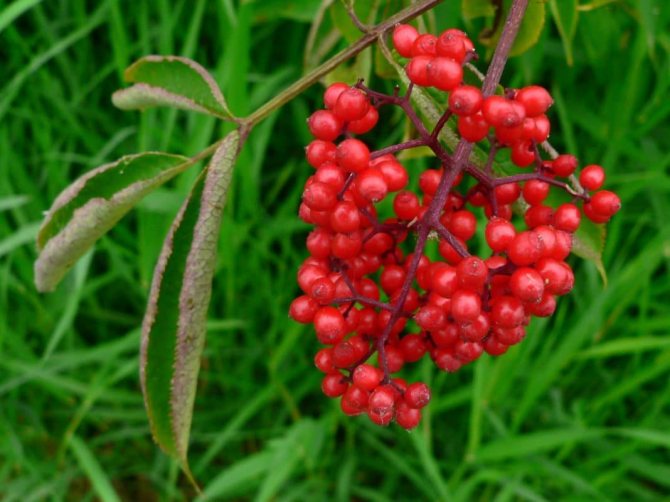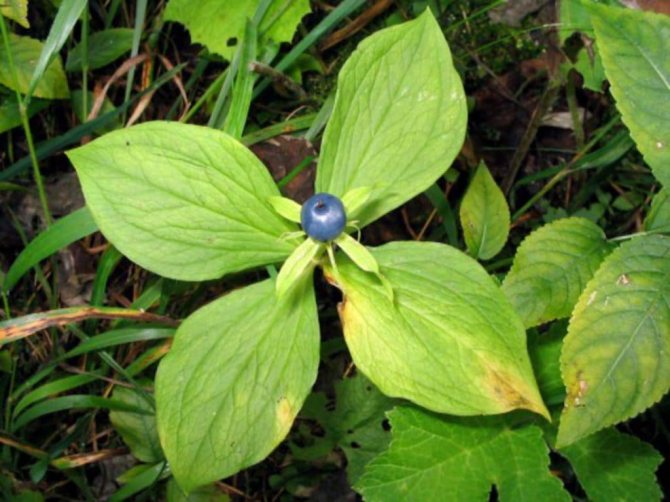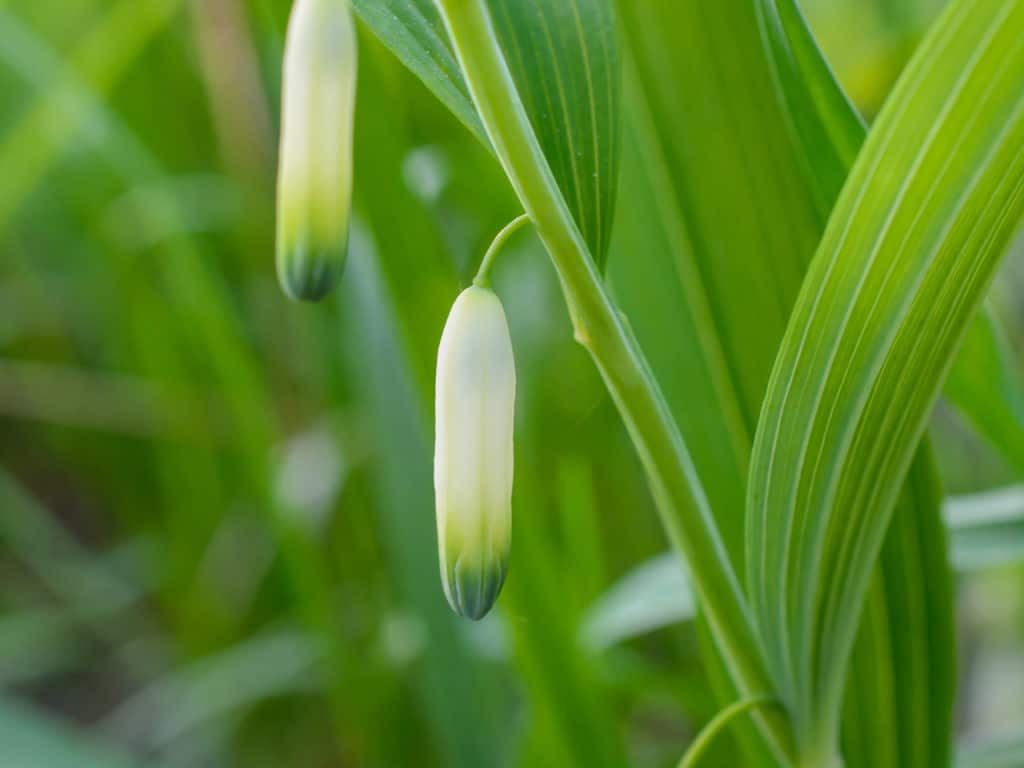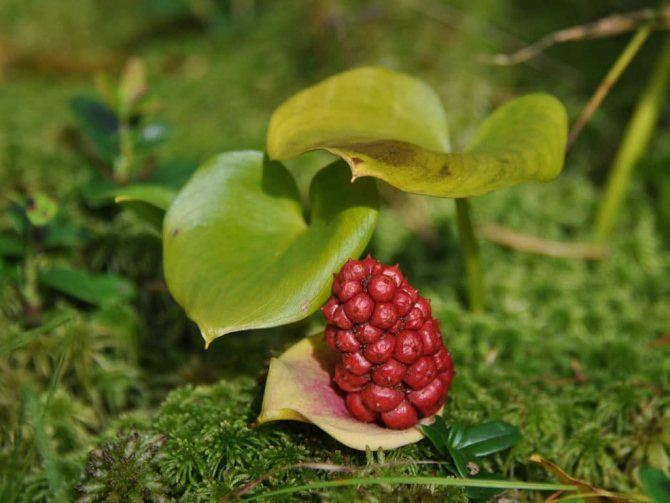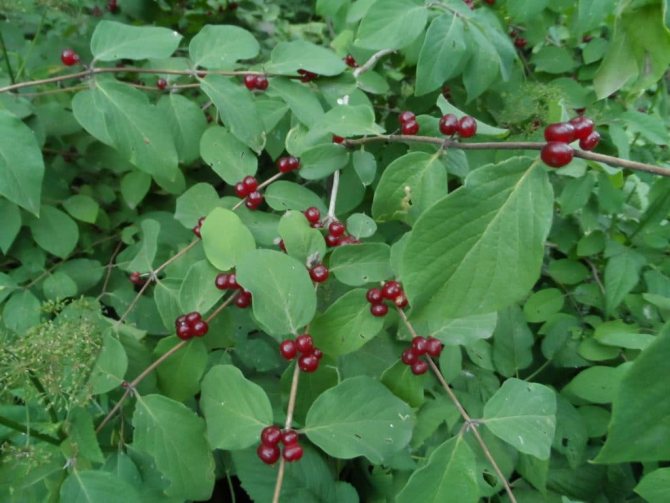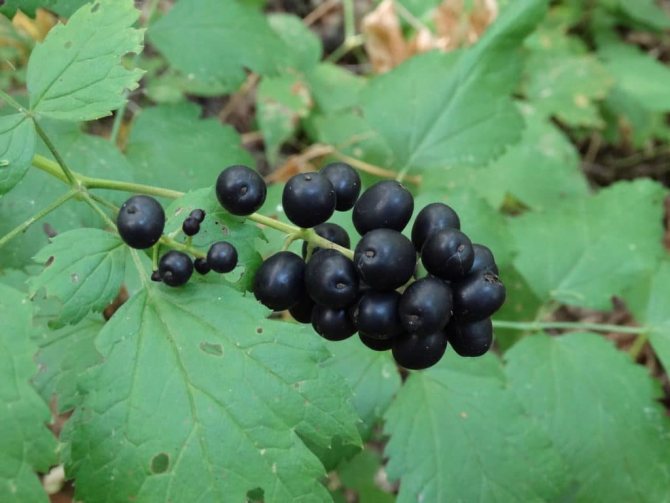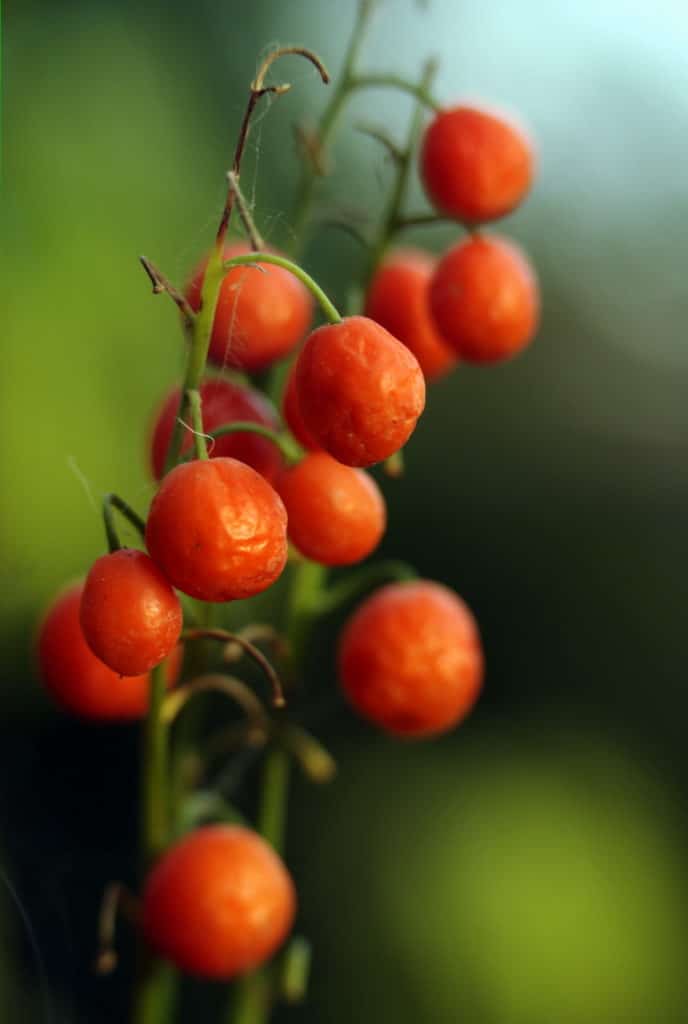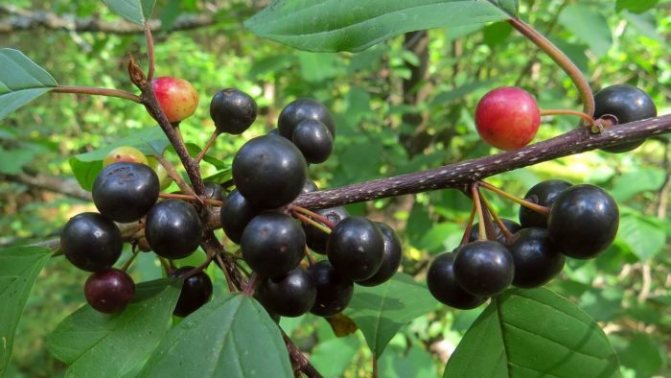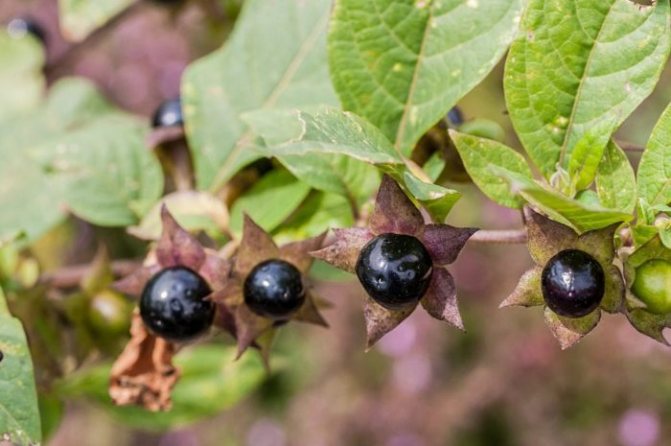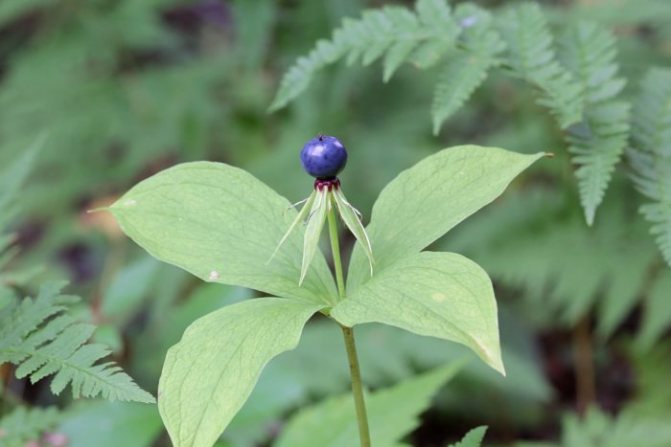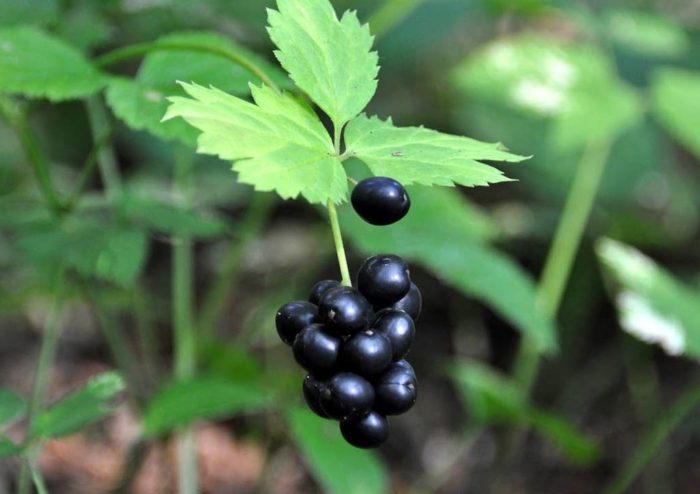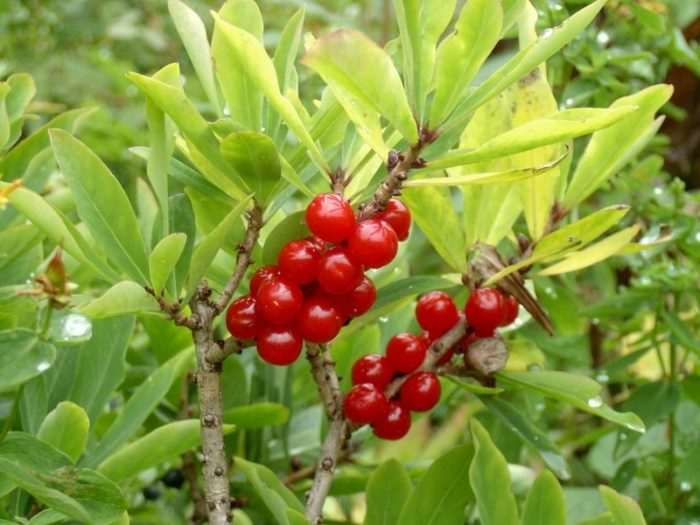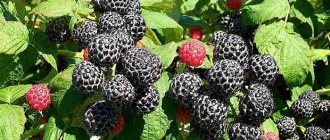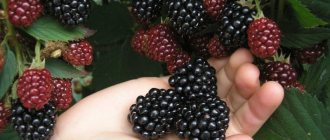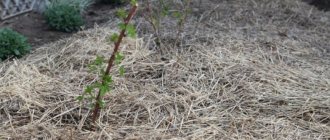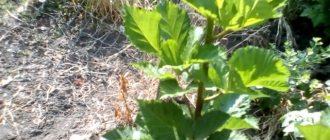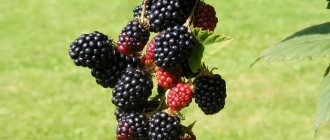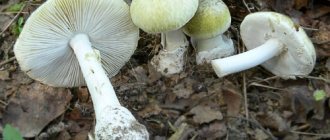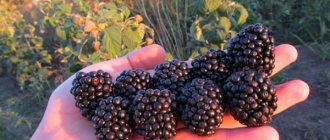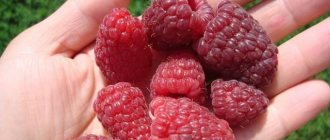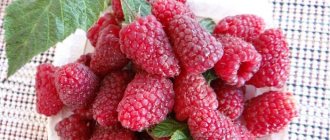Blackberry videos
Such incredibly tasty and healthy berries as black raspberries and blackberries are very similar at first glance, but still there are some characteristics by which they can be easily distinguished:
- ripening time of berries;
- appearance;
- picking berries;
- stem;
- bush shape.
In this table, the characteristics of bushy plants are widely disclosed.
| Black raspberry | Blackberry |
| The berries are round in shape, the size of the berries depends on its variety. It tastes sweet, has no sourness. The plant is cold-resistant, giving high yields. | The berries are oblong in shape, while their sizes vary from 3 to 10 g. The taste of the berry is sour. Low winter hardiness, but high productivity. |
Important! Black raspberry has a high vitamin C content, and the percentage of sugar in the berry is higher than that of red, which gives it a sweet dessert taste.
The appearance of the bush
The appearance of the bush determines its variety. A variety such as Cumberland has a large, powerful, spreading bush. And in a variety like Bristol, the bushes reach 3 m in height, which obliges their owners to garter them.
The variety Povorot has a very sprawling bush, with hard thorns, which greatly complicates the work of tying it, as well as harvesting. The height of the bush can reach 2.6 m. Height up to 2 m is found in the Udacha variety, and it also has a small number of thorns, which is liked by many gardeners.
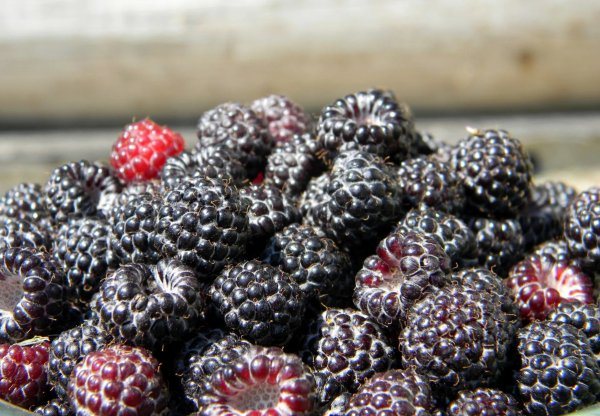
Black raspberry bush and berries.
But regardless of the variety, the appearance of the bush is as follows:
- the stems of the plant are of a falling green, even bluish hue, by winter they change color to brown;
- the shape of the leaf itself is similar to an egg;
- the flowers of the plant are collected in a brush;
- the petals are oblong;
- the fruits are initially green, then turn red in the process of ripening, and then turn black.
Did you know? The medicinal properties of blackberries have been known since the time of Dioscorides (more than 2000 years ago), and not only the berry itself is used for medicinal purposes, but also its leaves, flowers, and roots.
The blackberry plant also comes in different varieties, which may differ in appearance. So, the plant variety Thornless Evergreen has an evergreen color, and does not have thorns at all. A powerful blackberry bush Black Satin reaches 2 m in height, and has an erect appearance.
The powerful shoots of the Agave blackberry reach a height of 3 m, and they definitely require shelter for the winter. The Ruben variety, which has an upright appearance, does not require any supports at all, and is also frost-resistant, which is liked by many gardeners. The Navajo blackberry is completely thornless, has a straight appearance that reaches 2 m in height.
Blackberry bush and berries.
General appearance of all blackberry varieties:
- bush plant varieties look very similar to raspberries;
- have long shoots;
- the form of the shoots is upright, or semi-lodging;
- all wild berry species have thorny thorns.
Such a berry as blackberry has straight or curved hard thorns, the length of which is 1 cm. As for the black raspberry, its thorns are thin, fleecy, but there are a lot of them.
Blackberries have quite extended fruiting, which lasts from 4 to 6 weeks. Previously, wild blackberries began to bear fruit in the second half of summer, but over time, scientists have developed hybrids of varieties that can bear fruit at different times, which is very popular with gardeners. Now everyone can choose a berry variety depending on the desired ripening time.
Early varieties of blackberries give their first harvest in early June:
- Columbia is old.
- Natchez.
Mid-season varieties begin to give their harvest in July:
- Loch Ness.
- Loughton.
August and September are the ripening times for the late blackberry varieties:
- Triple Crown.
- Smutstem.
The black raspberry variety also has its own popular early, mid, and late varieties.
The gardeners' favorites among the early varieties of black berries are:
- Boysenberry.
- Cumberland.
Among mid-season varieties, one can distinguish:
- Coal.
- Luck.
Bristol is a late healthy berry.
Fruit appearance
The blackberry berry, unlike its black relative, resembles a red raspberry in shape, since it has an oblong shape with a glossy surface.
What can not be said about black raspberries, because it has a hemispherical shape, there is a slight hairiness on top.
Ripening terms
The growing season of ripening in blackberries is longer than that of its relative. Early varieties of berries ripen for about 1.5 months, while for late ones, their ripening period can take 2 months. Ripening of fruits can occur on the same branch at different times, which allows you to feast on this berry for a long time.
Raspberries, due to their cold resistance, ripen earlier and faster than blackberries, and in June the first harvest can be harvested.
Important! Repairing bushes of black raspberries are capable of producing a crop once a year, while blackberries are harvested before the first frost!
Taste qualities differ significantly, because black raspberries, unlike their relative, have no sourness.
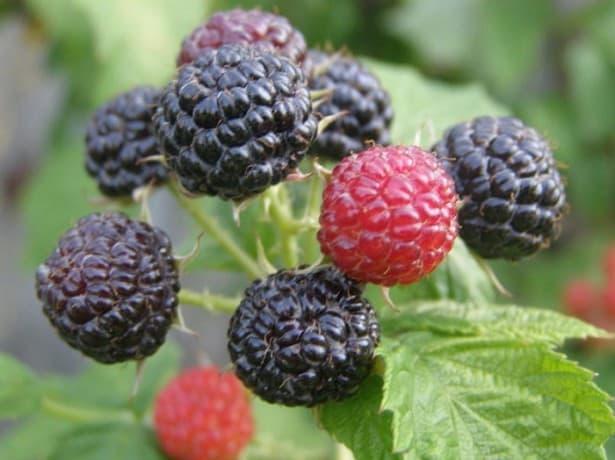

Blackberries have excellent properties that can be stored for a long time, moreover, if you create the right conditions for them (air temperature 0 ° C with 90% humidity), the crop storage period can reach 3 weeks. Harvesting a garden crop is either early in the morning or late in the evening, when the berries have cooled down from the scorching sun.
In order not to crush the fruits, put them immediately in a container intended for transportation.
Black raspberries should be harvested dry early in the morning when they are fully ripe. Harvesting containers must be spacious and have access to air from all sides. For storing berries, you need to create the right conditions (0 ... 2 ° C with an air humidity of 90–95%). Under these conditions, the berries can be stored for several days.
It is important not to overheat the harvested crop, otherwise it will lose its taste.
Differences in care
Interestingly, despite the fact that these two cultures are directly related, they do not get along with each other. That is, if you are planning to put them next to each other - this is a very bad idea, it is absolutely impossible to do this.
You can't even plant them after each other. As for the neighborhood with other plants, there are also a number of nuances.
- Do not plant these bushes near:
- potatoes;
- tomatoes;
- eggplant;
- other varieties of raspberries
As for the moisture resistance of berries, blackberries are less whimsical here. Black raspberries should not be left for a long time without watering, as their bushes immediately begin to wither. In their attitude to heat, related berries also differ, because raspberries can grow well in the shade, while blackberries simply cannot stand shade.
Blackberry is a plant that does not tolerate frost, so sheltering it for the winter is a must. While raspberries can even withstand frosts down to -25 ° C.
As for the resistance to diseases and pests of the two related crops, here they are equal. Because the same diseases and pests prevail over these plants. Therefore, the methods of struggle are also similar.
The most common diseases in these berries are fungal, such as:
- septoria;
- white rot;
- anthracnose;
- Ruby phragmidium mushroom;
- powdery mildew.
Among the pests of berry bushes, the following are distinguished:
- bear and its larvae;
- crunchy;
- walnut;
- raspberry gnat;
- aphid;
- ticks;
- leaf sawfly.
To avoid the attack of diseases and pests on plants, preventive work should be carried out, as well as strictly adhere to the rules of planting, growing, caring for these bush plants.
Reproduction
Blackberries, like black raspberries, have the same breeding methods, including:
- Sowing seeds - seeds for planting can be either purchased in a specialized store, or harvested from ripe berries by drying them.
- Dividing the bush - this procedure is carried out in spring and autumn, you should not choose old bushes for this.
- Reproduction by layering - for this, climbing varieties are chosen and laid in the ground.
- Reproduction by root suckers - in the spring, when the plant lets out its young suckers, they are separated from the common rhizome and transplanted to another place.
- Sleeping bud - in the fall, shoots are cut from the bush, which have 3 buds, for the winter they are placed in a cold room (basement, refrigerator). At the end of winter, they take it out and put it in the water with the kidneys.
- Cuttings - do it with green or stem cuttings.
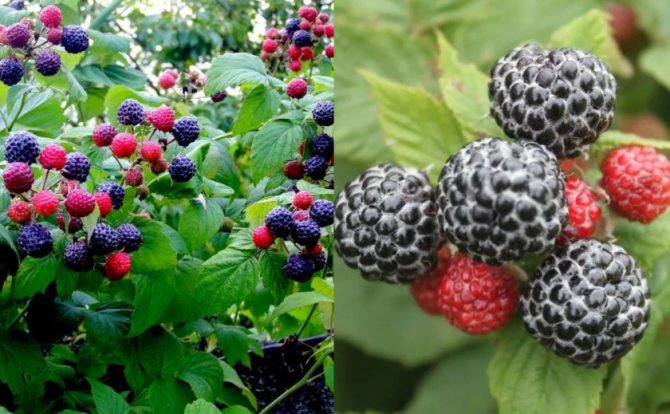

Blackberries are similar to raspberries. Inexperienced gardeners can sometimes confuse them, mistaking black raspberries for blackberries and vice versa.
Raspberry-like humble cloudberry
It is also called the swamp guard or the royal berry. Loves marshland with acidic soil. You can find it in the moss tundra and in the boggy peatlands, next to lingonberries and blueberries. Cloudberry is a semi-shrub 40 cm high, blooming with single white flowers from the end of June.
Fruits, initially red, become amber in color by maturity. Soft, juicy, sweet, it is 15 mm in diameter, sour taste. July is the month of collection, which lasts up to 2 weeks. Each berry individually grows on a straight stem and is clearly visible.
More on the topic: Raspberry variety Ruby Bulgarian
Ripe is very poorly stored, so it is harvested a little unripe and ripened within 2-3 days.
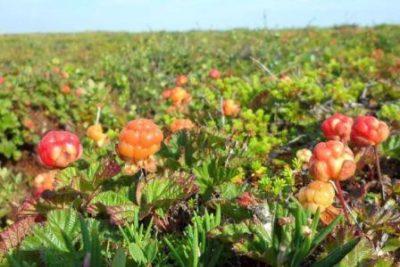

Short description
"Cumberland" reaches a height of 2 meters. A distinctive feature - thick curved shoots, covered with thorns and waxy bloom. Another characteristic feature is the absence of root suckers typical of most varieties. The variety blooms late - in June. The flowering and fruiting period is long. The yield is excellent. One bush gives 6-7 kg of fruit.
The berries are juicy, but they tolerate transportation well. The bushes are frost-resistant - there is no need to cover them. "Cumberland" is unpretentious in care.
Anyone can grow dark purple raspberries with a blackberry flavor. Even someone who has never done this. And the berry is also convenient to pick. With proper pruning, 10 brushes are formed on one shoot, each with 12-15 berries.
Mulberry Darkie
For the climate of the central region, the Smuglyanka variety may be suitable. Very pleasant to the taste, slightly sour fruits of the Dark Brown are 3 cm long and ripen very early. Already in June, you can taste the first harvest. And the productivity of this plant pleases the heart of the gardener - 0.5 kg of mulberry trees are harvested from each meter of the fruitful branch.
An important advantage of the variety is a high degree of adaptation to cold weather and short summer. Blackberry Mulberry is quite easily restored when the shoots freeze. This is facilitated by an interesting feature of the plant - the tendency to escape. With an early cold snap, the matured part of the branch forms a cork separating layer, discarding the unripe part, like a lizard's tail.
However, too severe and prolonged frosts have a negative effect on yields. Therefore, it is still better to insure the Darkie with a shelter. To do this, it must be formed so that the crown height does not exceed two meters, and with the onset of cold weather, tie the plant with spunbond in several layers.
Mulberry fruits in Asia are used as a medicine for tonsillitis, stomatitis and cough. The leaf infusion helps to lower blood pressure.


Fresh mulberry berries
Pros and cons
Lovers of this variety do not get tired of repeating that it consists of some advantages. Indeed, it has many advantages, but there are also disadvantages. Let's take a look at what is good about Cumberland and why it is bad.
Benefits
- high immunity to diseases and pests;
- frost resistance (the plant hibernates without shelter, even at a temperature of -40 degrees);
- quick adaptability to environmental conditions;
- high yield rates;
- the ability to consistently give good yields for 12-14 years;
- large fragrant berries;
- pleasant sweet taste with light blackberry notes;
- versatility of fruits;
- raspberries do not crumble or wrinkle during transportation.
As for the shortcomings, they also exist. For some, these disadvantages are not too significant, but for others it may be quite reasonable to refuse to plant Cumberland raspberries.
- thorny branches that make it difficult to care and harvest;
- large and hard bones in fruits;
- bushes need timely tying and regular pruning;
- in the process of harvesting, you will need trellises, which will greatly facilitate the work.
If the listed disadvantages did not frighten you (as is usually the case), you can proceed to planting. So, what do you need to know for those who decide to plant this beautiful variety on their site?
The prince is called arctic raspberry
People call it meadow, drupe, mamura, khokhlushka, noon. She also looks like a raspberry. Low plant 20-35 cm, creeping rhizomes. Hair grows on soft, thin shoots, as well as on triple toothed leaves. Autumn paints them burgundy.
A manifestation of the past, surviving the Ice Age, mamura grows on the outskirts of peat bogs, in rare forests, along the edges, between tundra bumps. The Finnish breeders called the hybrid with common raspberry "nectar".
It begins to bloom early, from May to June. It blooms for a long time, with very beautiful, single, bright pink large flowers. By the end of summer, in place of flowers, fruits appear, similar to bone, juicy red or cherry in color with the aroma of expensive wine. The taste is sweet and sour, reminiscent of pineapple.
More on the topic: Standard raspberry variety Bogatyr
Strawberry spinach-raspberry description
For our latitudes, strawberry raspberries are still a rarity. It is a lignified semi-shrub, which has fine-grained conical red berries on its fruit branches, which appear in September. The berries are very shiny, one might say glossy. Therefore, they are very popular with pastry chefs. They are good for decorating sweet pies, pastries and cakes. The height of the bush is 0.5 m. Propagated by layering, very aggressive in the garden.
Good for hedges as the branches are very thorny.
A very unusual annual plant with large, fragrant berries. Spinach raspberry has another popular name - Marya is many-sided. The correct name is multifoliate spinach.
Spinach height - 0.5 m. Multifoliate spinach branches from the very bottom of the plant, has a spreading shape. A very beautiful plant. And since the berries do not crumble, and have a very long shelf life, such an exquisite decorative effect is very pleasant to many gardeners.
Fruits are juicy, sweet, large, elongated. Compound fruits, similar to raspberries, are attached at the base of the petioles. The yield is very high. The plant has edible not only fruits, but also leaves. They have medicinal properties. Multifoliate spinach is a cold-resistant plant that perfectly tolerates the aggression of spring frosts, so the seeds are boldly sown directly into the ground.
The appearance of the bush
What is the name of the black berry, only grows on a tree?
The most famous black berry, which resembles black raspberries or blackberries, is the mulberry, the fruit of the mulberry tree. Under natural conditions, such a tree grows up to 20 m, with several thick trunks. Mulberry grows in warm southern regions.
Interesting! White mulberry is grown in China for natural silk. The silkworm processes the leaves of the plant, and the resulting threads are used to make high-quality silk.
The berries of the white mulberry are also eaten, used for cooking preserves, jams. The tree grows and bears fruit for over 200 years, growing up to 30-35 m. The black mulberry is slightly lower, with delicious juicy berries that have a grape flavor.
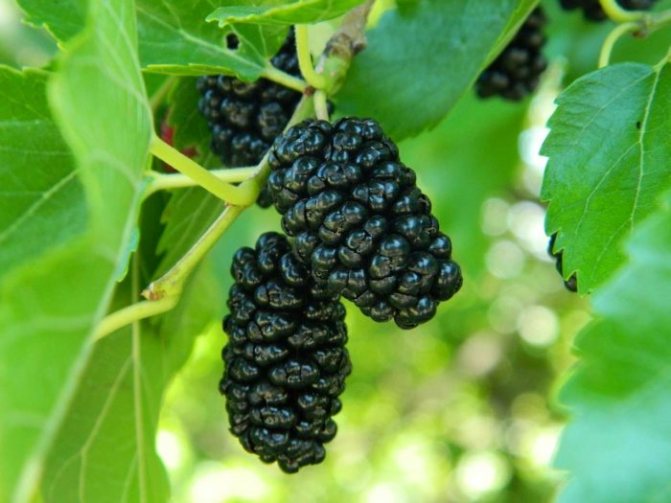

How to plant?
The best time for planting is spring and autumn. Raspberries of this variety should be planted in areas that are well lit by the sun, but well protected from the wind. Cumberland prefers light loams or nutritious sandy loams. Avoid planting where potatoes, tomatoes, red raspberries, and blackberries have recently grown. The depth of the planting holes is 0.5 m, the interval between them is 1.5 m. Experts advise planting in two rows.
Humus and wood ash are poured into the pits in equal amounts. The seedlings are installed strictly vertically and carefully covered with earth mixed with any complex fertilizer. You can use superphosphate and potassium sulfate 200 g each. and 80 gr. respectively. Then the soil is watered and lightly tamped.
Not sure how to make such supports? It's simple. At the beginning and at the end of the beds, strong piles with a height of 2.5 meters are dug in. Wire is wound on them in three rows. Done. Many gardeners assign raspberries the role of a hedge, fixing the shoots on the fence of the site.
Berry mulberry
The juicy drupe of the mulberry is very similar in appearance to the fruit of the garden blackberry. The same slightly elongated shape, the same purple-black color. True, this plant is not only black-fruited, but also white. And yet, for consumption, it is the black mulberry (it is the mulberry) that is most often cultivated.
You can only confuse mulberries with blackberries by looking at the fruits. Her taste is completely different, unlike anything else, very sweet, with an unusual aroma and aftertaste. And the morphology of the plant is completely different. This is not a shrub, but a tall tree (up to 20 meters), sometimes growing in several trunks. For the convenience of cultivation, cultivated mulberries are formed with a stem of 1.5 meters - in this case, it does not grow above 4 meters.
Of the most popular mulberry trees, the interesting variety Shelley No. 150 can be noted. The name comes from the first syllable of the word "mulberry" and the initials of the creator of the variety, Leonid Ilyich Prokazin. The fruits of this plant are of excellent taste and reach a length of 5.5 cm. Shelley's leaf plate is gigantic, 0.5 in length.
The black mulberry tree is very thermophilic. In Russia, it is grown in the North Caucasus and in the Lower Volga region, where it is often found in the wild. Surprisingly, even in the middle lane, mulberries are sometimes cultivated very successfully.
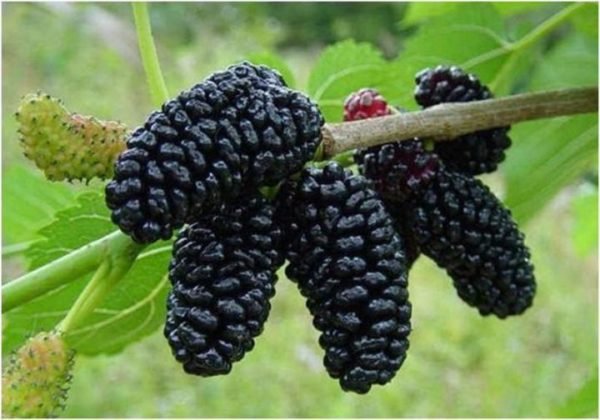

Mulberry - a berry similar to a blackberry
Learning to look after
Raspberry "Cumberland" is unpretentious in care. In order to collect rich harvests every year, it is enough to follow simple rules.
Irrigation regime. Watch the soil - it should always be moist. In the summer, the water consumption per bush is 3 liters.
Pruning. Branches that have reached a length of 70 cm are pruned by 10 cm. This will slow down the elongation of the shoots and activate the growth of the lateral processes. But keep in mind, at the beginning of the growing season, the side branches are shortened, leaving 4-6 buds. Weak shoots are cut at the root without regret.
Direct the fruiting branches to the lower tier, located at a mark of 60 cm from the surface of the earth, direct the young ones up. After the shoots have grown to the last row of the wire support, they must be tied up and directed horizontally along it. After the end of fruiting, the old branches are removed.
Preparation for wintering. This variety tolerates frost well, but temperature changes can harm young plants. Before the arrival of frost, remove the shoots from the wire supports and bend them to the ground, but so that they do not touch it. After the snow falls, the currants are sprayed with water.The resulting ice crust will serve as a kind of protection. With the arrival of spring, the raspberries are again hoisted on the supports and the branches are straightened. Dried and damaged shoots are cut off.
Fertilizer. During the growing season, they are fed three times. The first time - at the end of flowering, the second - during the intensive development of the berries, the third - after the ripening of the raspberry. An aqueous solution of bird droppings or mullein is used as fertilizer. Add 100 gr. To the mixture. superphosphate and 1 liter of ash. Consumption - 5 liters per bush. After fertilization, the plants are watered abundantly.
Useful properties of mulberries and blackberries
Mulberry and blackberry are among the most beneficial berries for the health of the human body.
- Blackberries have not only useful berries, they also use bark, leaves and root:
- Berries are consumed fresh to strengthen the immune system, strengthen the protective functions of the body.
- The infusion of the leaves helps to normalize digestion, has a diaphoretic, diuretic, antipyretic effect, is good for the heart and nervous system. For cooking, take 2 tsp. dried leaves, pour 1 tbsp. boiling water, stand for 20 minutes. The tincture must be consumed during the day in 3 approaches. Can also be used to rinse the mouth for inflammation of the gums.
- For diseases of the gastrointestinal tract, take 1 tbsp. l. dry leaves, fall asleep in a thermos, pour 1 tbsp. hot water and insist for 3 hours. Consumed 3 times a day 20 minutes before meals.
- Inflammation of the lungs is treated with a decoction of blackberry roots and leaves. You need 20 g of dried ingredients, pour 1 tbsp. boiling water and boil for 20 minutes, then add boiled water so that the volume of the broth becomes 1 glass, soak for 3 hours. Take before meals 3-4 times a day for 2 tbsp. l. The same proportions are used for jade. You can gargle with broth.
- With diabetes mellitus 2 tbsp. l. dried leaves need to be poured with 1 tbsp. boiling water, leave for 30 minutes, use in 3 approaches during the day.
- The juice of young leaves is applied to wounds, used to treat ulcers and eczema.
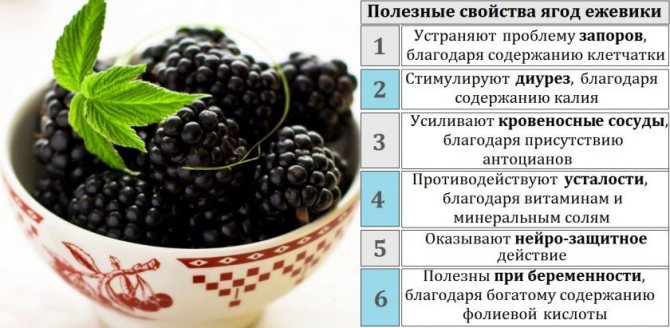

- Mulberry fruits and leaves have very useful properties:
- The use of berries during the season will strengthen the body, restore protective functions and strength.
- Mulberry fruits have a high level of potassium, which is good for the heart.
- Berries have a positive effect on lowering blood insulin levels.
- Tea from 2 tbsp. l. dry mulberry leaves, poured with 1 liter of boiling water, are used to treat cough, as an antipyretic for colds. Recommended for strengthening the heart muscle. Has a positive effect on relieving symptoms during menopause. Recommended for improving metabolism.
- If you add mint when brewing tea, you can lower your blood pressure.
- Rinsing hair with tea after shampooing will result in silky, healthy hair.
- If you freeze the tea in cubes and wipe your face in the morning, your skin will look fresh.
Important! Blackberries are rapidly gaining popularity as an industrial crop. Easy to care for, disease resistant, it gives generous yields and good profits.
Despite the external similarity in the form of blackberries and mulberries, they are completely different plants. The discrepancy lies not only in belonging to different families. The difference is also expressed in the method of cultivation, fruiting, care, and the amount of harvest.
How to fight disease?
Raspberries are resistant to many diseases and pests, but certainly not all. The purple spot gives itself out as purple spots on the shoots. Most often affects young stems. To combat this scourge, 6% urea and 1% Bordeaux liquid are used. The mosaic can be recognized by the yellow rings on the leaves. Sick bushes are dug up by the roots, the rest are treated with Karbofos.
If you find a cobweb on the back of the foliage, then a spider mite has chosen raspberries.Fallen leaves should be burned, and after flowering, the bushes should be treated with PhytoFerm. After harvesting, spray with Karbofos. Spark or Decis will save you from bud moths and stem flies that lay eggs in the axils of leaves and in flowers.
That's all you need to know in order for Cumberland raspberries to grow on your site by leaps and bounds. Follow these simple recommendations and you will have something to surprise your guests with - dark purple raspberries with a blackberry flavor.
A source
Exotic raspberry-like mora
Blackberry of the Andes. Tall, up to 3 meters, a bush belonging to perennial plants. Habitat - Central and South America.
He loves to grow in sunny places, grows strongly, not giving room to his neighbors, forming impenetrable thorny thickets. It can grow high in the mountains, as it is not afraid of a 10-degree cold.
Due to the interesting shape and color of berries, mora is used to decorate gardens. Small round and large oblong fruits, weighing up to 5 g, size 3 cm, rich raspberry and purple hues, sweet tart taste and pleasant smell.
Reproduction of black raspberries
It is recommended to start breeding black raspberries towards the end of summer. You can use the layering method - the branches of the bush are pulled out and bent in the shape of an arc, after which they are pressed to the ground. If this method is used, it is necessary to first prepare trenches, the depth of which is no more than 10 cm.
The procedure for reproduction of shrubs by the trench method is very simple to perform:
- Carefully place the stems in the prepared trenches and sprinkle with a layer of earth on top.
- Make sure there is a point of active growth above the ground.
- Before the start of frost, sprinkle the stems with a layer of sawdust and peat. This will serve as additional insulation.
- In the spring, carefully separate the rooted shoots, and then carry out a separate planting.
In the video presented, the gardener talks about the reproduction of black raspberries:
Black raspberry
In nature, there are several varieties of raspberries - the usual red, as well as white, yellow, orange and black. Berries of black raspberries have a blue-black color with a silvery bloom, they are similar in shape to a thimble and can be easily removed from the axis - unlike blackberries. They are winter-hardy, form a graceful shrub with curved shoots, give small and sweet berries like candy.
Black raspberries were introduced into cultivation in the 19th century in the United States, breeders have successfully bred several varieties: Remontantnaya, Evans, Bristol, Dundee. In modern Russia, two varieties are cultivated: Cumberland and Ugolyok. Cumberland has taken root in our country due to its winter hardiness (up to –30 ° C). The plant forms a bush with shoots up to three meters in height. The shoots are covered with sharp thorns and grow like a semi-creeping blackberry - they bend during regrowth. Such raspberries make wonderful hedges. Ripe black raspberries remain dense and do not spread into porridge, the seeds in them are somewhat larger in comparison with ordinary red ones. As for the taste, they are noticeably sweeter than red, without a hint of sourness. The Ugolek variety was bred relatively recently specifically for cultivation in the territory from the Urals to the Far East.
Characteristics of black raspberries
Black, or blackberry-like raspberries - a perennial shrub with a two-year growing cycle - shoots grow in the first year, and begin to bear fruit in the second. Annual shoots are thin, branched, covered with a bluish bloom, with tops hanging down. Biennials are woody, brownish, with an intense bluish or lilac bloom, covered with small spines. Flower buds are formed on them, and then racemose inflorescences.
The root system is deep and highly developed.Unlike varieties with red berries, root growth does not give, therefore it multiplies by layering and rooting of the tops. The bush is compact, the lashes are long (2-3 m), arched, require pruning.
The berries are complex drupes of medium size, round in shape, black in full ripeness, with a bluish bloom and light hairiness. They are easily separated from the receptacle, but they do not crumble and are stored for a long time without losing density. Sweet dessert taste (sweeter than red raspberries), without acid.
Most varieties have a high immunity to cold - they can withstand temperatures of -20-25 ° C, but it is better to cover for the winter. Plants are not demanding to care for, unlike varieties with red berries, they are not susceptible to disease, and are practically not damaged by pests. The yield is high - 2-4 kg per bush, but depends on the variety. The fruits are dense, well transported, and amenable to any processing.
Plant Berry Lakonos
An exceptionally rare plant in our latitudes, surprising with exotic fruits. Segmented juicy black fruits on long "cobs" look like blackberries.
It is a herbaceous plant of the Phytolaccous family native to North America. Perennial, annually producing several thick stems, up to 1.5 meters high. Long erect inflorescences of lakonos appear at the end of May and vaguely resemble hyacinth flowering. The many greenish-pink flowers give the plant a very decorative look.
The fruits of the berry lakonos ripen by the end of summer. By this time, it acquires a red color more fertile, and against its background black "blackberries" look amazingly impressive. The juice of this plant has a rich, dense scarlet color.
As Paracelsus said, "everything is poison, and everything is medicine." Lakonos is indeed recognized as a poisonous plant. Under no circumstances should children or pregnant women be allowed to feast on black berries. And adults need to treat them with great discretion. Many cases of severe cardiac arrhythmias associated with the use of the lakonos are described.
And yet you can try to find a practical application for this interesting plant. Traditional medicine knows a recipe from the roots of the lakonos that can relieve rheumatic pains.
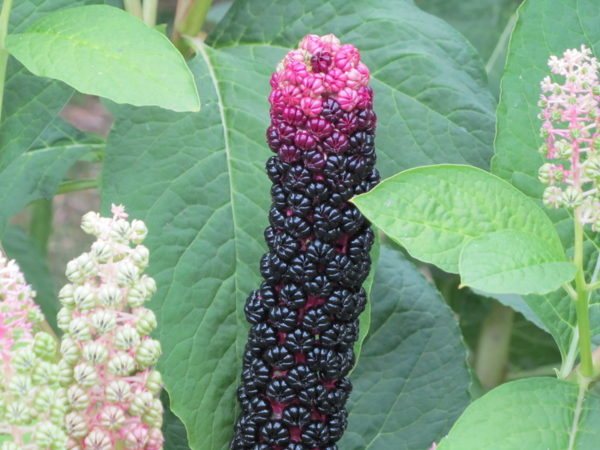

Garden plant berry laconos
- 0.5 cups lakonos roots;
- 1 glass of vegetable oil or kerosene.
Chop the roots, mix with the base and leave in a dark place for ten days. Rub the sore joints with the resulting product.
In the list of berries similar to blackberries, one could also note the jemalina. For example, the very popular varieties Loganberry, Tayberry or Michurinsky Progress. But ezhemalina is still almost a blackberry, a product of hybridization. Therefore, it deserves a completely separate discussion.
At first glance, the berries of mulberry (mulberry) and blackberry (azhina) are exactly the same. Especially if they are in a vase or on the market in a glass from a seller, that is, not on a tree or bush. In fact, they are quite similar, but they belong to different cultures. One from the Mulberry family, the other - Pink. The fruits of the first grow on a tree, the other - on the bushes.
Polar berries: list, names, photos
Before writing an extensive article about northern berries, I would like to know which areas can generally be attributed to them. So, for example, in Russia these areas can be considered the Kola Peninsula, Karelia, a strip of tundra, taiga up to Chukotka. In general, the entire upper part of Russia. And in the whole world, these areas can be considered Norway, Finland, Canada, Iceland, Greenland, Canada and Alaska. In the Southern Hemisphere, these areas include only the south of South America, the Falkland Islands.
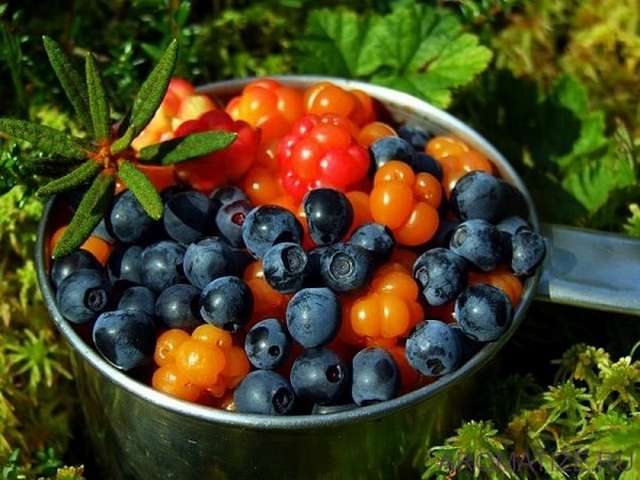

After we have decided which areas belong to them, then the berries will be described further grouped by special groups. So first poisonous berries will be described, then the berries that grow in these areas, but they are not usually called "local" and the berries that are usually attributed to them.
To begin with, I would like to tell you about two berries that are not worth eating.
Everything, I did not find more known poisonous berries in these areas. Perhaps there are some other inedible berries, but there is little information about them on the Internet.
There is another berry that is not poisonous, but of no interest to humans. This berry Swedish dogwood.
It is a shrub up to 25 cm. The fruit is a red berry-shaped drupe. Swedish dogwood is not poisonous, but its berries are loose and tasteless, with large hard seeds. Swedish dogwood, along with Canadian turf, was eaten by Canadian Indians and Eskimos. The berries vaguely resemble a bunch of lingonberries, the same bright red. However, if there is a depression on the lingonberry at the tip of the berry, then there is a black dot.
What taste
Fruits similar at first glance have a huge difference in taste. Mulberry gives tender, very sweet fruits that contain a large amount of sugars, polyunsaturated and monounsaturated fats, proteins, dietary fiber, vitamins B, A, D and K, as well as many other elements necessary for our body. Berries and leaves are often used in folk medicine. Young leaves contain a lot of ascorbic acid.
Blackberry fruits have a richer taste, since the composition, in addition to vitamins (including vitamin C) and macronutrients, includes the following acids: salicylic, citric, tartaric, blocky. They are harder, but sour-sweet in taste, often have a pleasant aroma. Berries are consumed fresh, frozen, tinctures, wines, and all kinds of desserts are prepared from them. The berries and leaves are also used in traditional medicine.
Popular varieties of plants of different colors
There are several other plants whose berries are very similar to raspberries. These include the Logan berry, or ezmalin. It is a popular blackberry / raspberry hybrid that blooms all summer. The fruits are large, ripen in October – early November, but are not used fresh.
A very tasty, aromatic, dark cherry berry with a sweetish-sour taste - this is a princess. A low herbaceous plant found in forests and peat bogs.
Reference! Breeders have bred many varieties of raspberries, the berries of which can be not only red, but also yellow or white.
Yellow
Yellow raspberries are much sweeter and tastier than red ones, but they do not last long. The berries can be eaten fresh or used for processing.
Yellow raspberry varieties:
- Amber - medium late variety with small but tasty, sweet and aromatic berries. Not susceptible to diseases, and begins to bear fruit from the end of July to September.
- Runaway - is not considered a fruitful variety, but it has an extraordinary taste and aroma. It is not afraid of fungal diseases and pests, but it can suffer from spider mites.
- Golden autumn Is a remontant variety with large berries and high yields. Fruits until the very frost, is not afraid of temperature changes, but loves sunlight very much.
These popular yellow-fruited varieties are unpretentious and undemanding to care, give good yields with minimal effort.
White
The first varieties of white raspberries appeared in the last century, but in terms of taste they were inferior to ordinary red berries. Thanks to breeding work, many noteworthy white-fruited varieties have appeared.
The best white varieties:
- Golden Everest Is a well-known remontant variety with large berries. The fruits ripen in early autumn and have a pleasant sweet and sour taste. The plant is not afraid of frost and disease.
- Honey raspberry - refers to ordinary, non-remontant varieties. The yield is up to 8 kg per bush. Raspberries are resistant to any diseases and pests, but they are afraid of low temperatures. The berries are large, white, with a bright aroma and sweet taste.
- Spirina white - frost-resistant, medium-yielding, but with very large berries. This is the oldest variety, bred over 100 years ago, but not widely used.
White berries contain less acids and more glucose, but they retain all the beneficial properties of red raspberries.
Red
Red raspberry, traditional and familiar to gardeners, grows in almost every summer cottage. Popular varieties:
- Early : Glen Ample, News Kuzmina, Vera, Lashka.
- Average : Balm, Shiny, Candy, Maroseyka.
- Late : Ruby, Terenty, Firebird, Brigantine.
All these varieties differ not only in the ripening period, but also in the size of the berries, yield, and disease resistance.

